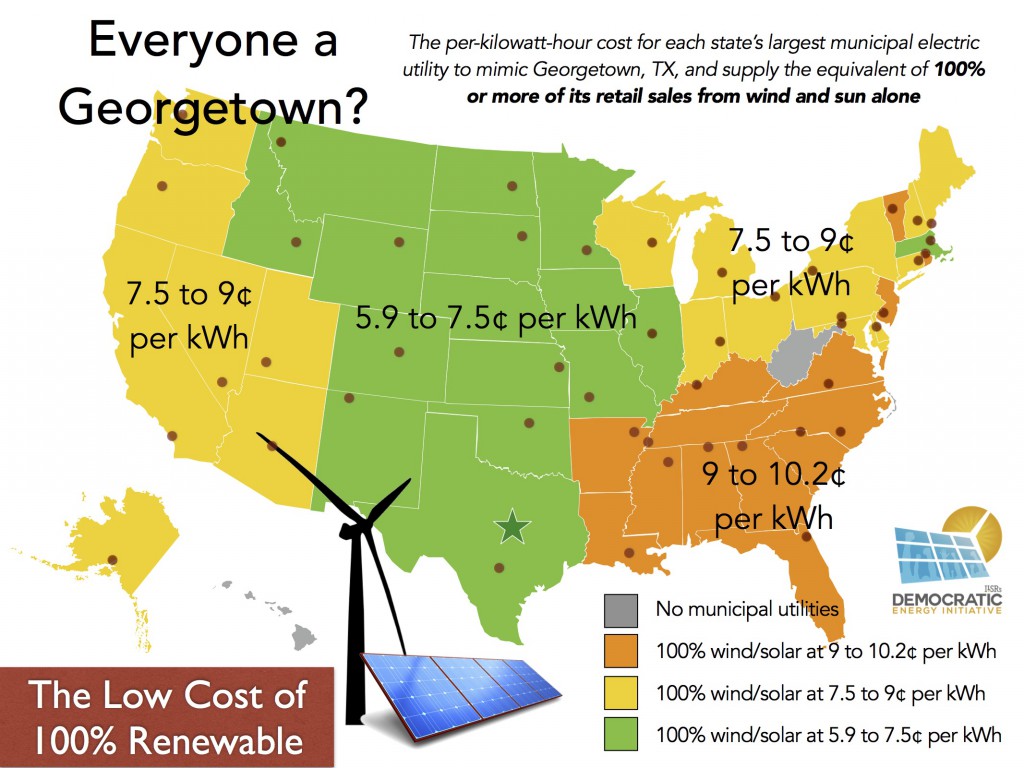Is Georgetown, Texas a model for other cities to follow to make a switch to 100 percent renewable energy?
John Farrell
BioCycle August 2015

Georgetown pursued 100 percent renewable energy simply because it was the best investment for their customers. Photo courtesy of Hill Canyon WWTP, Thousand Oaks, CA
This article is probably not the first place you’ve read about Georgetown, Texas, the town of 55,000 that will be getting the equivalent of 100 percent of its electricity from renewable energy by 2017. But few articles hit upon the two key reasons Georgetown was able to make this move when so many other cities with abundant renewable resources (e.g. Tucson, Arizona) are stuck with a majority-coal-fired electricity supply.
If cities had these keys, many could obtain 100 percent renewable energy at a surprisingly low cost:
Key #1: Local Ownership
Just one in seven Americans gets their electricity from one of about 2,000 municipal utilities, but these locally controlled utilities allow a community to chart its own electric future. It’s the key behind Palo Alto, California’s surge toward carbon neutral electricity, toward Austin, Texas’ 35 percent renewable by 2020 goal, and Sacramento, California’s ability to pursue a 90 percent reduction in greenhouse gas emissions from electricity by 2050.
Unfortunately, this local self-determination isn’t enough, because there are many other municipal utilities with only a pittance of renewable energy on their grid system. And that leads to…
Key #2: No Contracts
The Georgetown municipal utility closed its last power plant in 1945, and has contracted with third parties to provide electricity ever since. With the expiration of its major supply contract in 2012, it was free to sign new contracts. This freedom is what has allowed other utilities like tiny Farmers Electric Cooperative in Iowa to become the number one solar utility in the country.
Feasibility For Replication
Georgetown didn’t pursue renewable energy for environmental reasons, but simply because it was the best investment for their customers. The 150 megawatts (MW) of solar PV and 145 MW of wind power will supply as much as double the city’s annual electricity use, ensuring sufficient supply year round even with fluctuations in sunshine and wind, and allow the town to sell the excess into Texas electricity markets. As attractive as the price — which was lower than Georgetown’s current wholesale electricity costs — the solar and wind contracts have zero volatility because they have zero fuel cost, insulating Georgetown electric customers from rising fossil fuel prices.
Self-Reliance Not Self-Sufficiency
It’s worth noting that the solar and wind contracts don’t mean that Georgetown will be completely reliant on the sun and wind. Their grid remains interconnected to the rest of the Texas electricity system, so in periods of zero wind and zero sun, the town can still tap into the ERCOT (Electric Reliability Council of Texas) spot market for power. However, the wind and solar resource tend to balance one another. Noted the press release issued by the City of Georgetown when it announced becoming 100 percent renewable, “This means that wind power can most often fill power demand when the sun isn’t shining.”
A Low Cost Copy?
Could other cities follow suit? If they had the two keys that Georgetown did, almost certainly. The Institute for Local Self-Reliance’s (ILSR) analysis suggests that the path to 100 percent renewable energy is surprisingly inexpensive.
ILSR’s approach to evaluating replicability was to analyze the path to 100 percent renewable energy via wind and solar power alone, for the largest municipal electric utility in each state (i.e. cities with Key #1, and hopefully a timeline to obtain Key #2). We created a map to plot our data and found that 15 of the largest city-owned electric companies (mostly in the Midwest) could contract for 100 percent renewable energy at 7.5 cents/kilowatt-hour (kWh) or less. Another 18 could do so for less than 9 cents/kWh. The final 14 could contract for 100 percent wind and solar for 10.3 cents/kWh or less. Assumptions used in this calculation are in the sidebar.
 The map* (above), which can be viewed on this ILSR web page is pretty clear: Georgetown may be the first municipal utility to procure 100 percent renewable energy (and not just renewable energy credits), but it won’t be the last. As costs continue to fall for renewable energy, many more cities can make the rapid shift to 100 percent wind and sun.
The map* (above), which can be viewed on this ILSR web page is pretty clear: Georgetown may be the first municipal utility to procure 100 percent renewable energy (and not just renewable energy credits), but it won’t be the last. As costs continue to fall for renewable energy, many more cities can make the rapid shift to 100 percent wind and sun.
*Reported cost is the weighted average price of power, based on the mix of wind and solar resources.
John Farrell directs the Energy Self-Reliant States and Communities program at the Institute for Local Self-Reliance and he focuses on energy policy developments that best expand the benefits of local ownership and dispersed generation of renewable energy. This article was originally published on the Institute for Local Self-Reliance website at http://www.ilsr.org.













